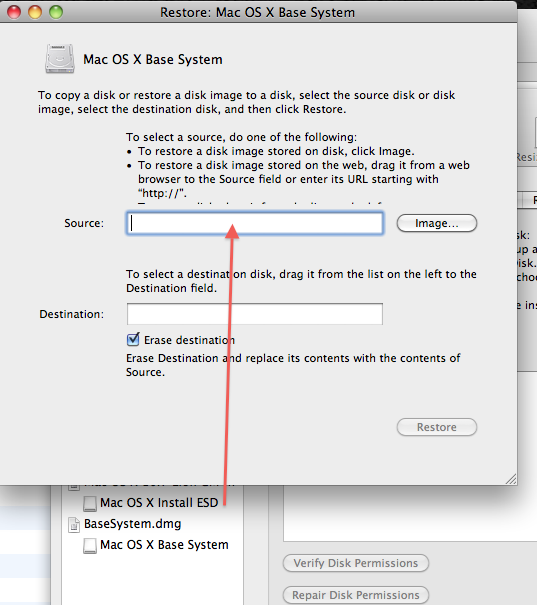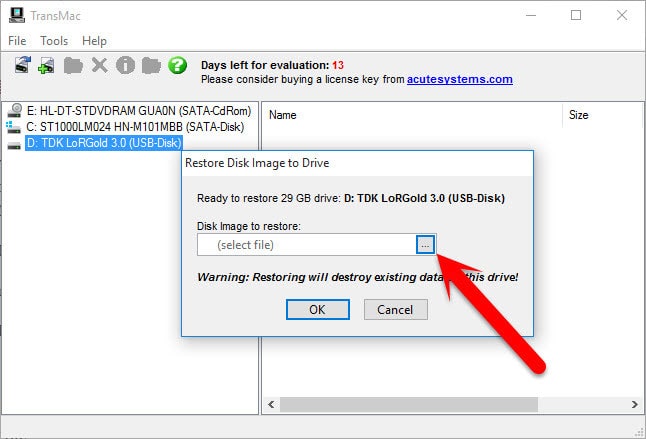Create Bootable Drive: Select the 'Create USB bootable drive' option and click on 'Create'. A pop-up dialogue will appear that will prompt the user to format the USB drive. Format the Drive: Click on 'Format' Now. Recoverit will show you the process of formatting the USB drive and creating a bootable drive. Step 1: Click Terminal icon from the Dock. Or Go to the Applications folder on Mac and find the Terminal app in Utilities folder. Step 2: Copy the ISO file in a convenient location so your command doesn't have to be too long. Saving it to desktop or downloads folder is usually a good idea. Plug the USB Drive in to your Mac and open “Disk Utility” (found under applications / utilities in finder) Select the USB Drive; Select the Erase tab; Ensure that the format is Mac OS Extended (Journaled) IMPORTANT – Leave the name as “Untitled”. If you change this the next step won’t work. Create the Bootable Mavericks USB Drive.
Looking for the best ISO to USB burner for Mac? It's possible, but ISO is not native file type in Mac OS X or macOS environment, so you need to use workaround methods or employ a third-party ISO burning utility for Mac to get this done. This article covers three ways to burn ISO to USB stick on a Mac computer, powered by macOS Catalina, Mojave, High Serria and earier Mac OS X systems.
The first thing you need to know is that you can't use an ISO disk image file on a Mac, since Apple primarily uses the DMG format. However, if you merely want to burn ISO to a USB stick, that's definitely possible. The only thing you can't do is run an ISO file on an Apple computer. Let's look at the various ways to burn ISO to USB on a Mac machine.
Notice: There are different types of ISO images (Windows, Linux, Raspbian OS, etc.) and they apply different booting schemes. So basically, there is not a perfect software out there that can burn all ISO images successfully. You should try another suggestion if one failed.
Updates: If you have any question during ISO burning process, please check out the FAQ Part at the end of this article.
Part 1: How to Burn ISO to USB on Mac with Terminal Software
Terminal is Apple's command line equivalent of Command Prompt in Windows and Terminal in Linux. Using this command line utility, you can burn an ISO file to an external DVD or USB disk. If you did not t have any experience with text command, then this is not recommended because it is too risky to damage the local disk with wrong input. Terminal allows you to do several system-level operations, so don't input anything other than the commands specified in the process outline shown below:
Step 1: Click Terminal icon from the Dock. Or Go to the Applications folder on Mac and find the Terminal app in Utilities folder.
Step 2: Copy the ISO file in a convenient location so your command doesn't have to be too long. Saving it to desktop or downloads folder is usually a good idea. Make sure you remember the name of the ISO file because it will be used in the command.
Step 3: If your ISO file is in your Desktop, then run the following command (press Enter after typing the command): cd desktop
Step 4: Now run the following command (hit Enter after typing): hdiutil burn filename.iso
Step 5: Once you run the command, your ISO file will be burned to the USB drive in your default optical drive. If you haven't inserted a disk, you will be prompted to do so. There is no need to run the command again after inserting the USB.
Cons:
Create Bootable Usb Mac Disk Utility

- Dangerous and not safe for beginners.
- Sharp learning curve.
- Bad support for USB 2.0 device.
- Lower success rate.
Create Bootable Disk Image Mac Disk Utility
If you want to avoid any kind of command line work and if you're running one of the newer versions of macOS, then it's better to use a third-party software like the one described in Part 2 below.
Part 2: Easily Burn ISO to USB on Mac via UUByte ISO Editor (Bootable USB Creator)
Sofware being powered by a graphics user interface are always welcomed because of user friendly operation. So the second suggestion in here is UUByte ISO burner software called ISO Editor for Mac. It is popularly regarded as the best ISO burning software for Mac. It allows you to burn, extract, edit, copy and create ISO almost as if it was a native file format on Mac. The utility has been fully tested on a wide range of storage media brands as well as all versions of macOS and Mac OS X.
The biggest advantage is that you do not need any technical expertise whatsoever to use this software. It is highly intuitive, and in a matter of minutes you can burn your ISO to USB or DVD. More importantly, the USB is bootable in default. This flexibility makes it the most user-friendly Mac app for handling ISO disk images in a number of ways. The next section shows you how to easily and quickly burn any ISO file to a disk or drive to create bootable USB on your Mac.
Key Features of ISO Editor for Mac

- Designed by great UI.
- Powerful Burning options.
- Able to make bootable USB or DVD.
- Support the latest macOS Mojave and High Serria.
- Include other useful ISO tools such as edit, extract and create.
Step 1: Download UUByte ISO Burner for Mac
Download and install ISO Editor for Mac to your computer and launch the program. Click on the Burn module on the first page, which will take you to the ISO burning utility.

Step 2: Insert USB Drive on Mac and Import ISO Image
Insert a USB flash drive into your Mac. Select the ISO file to be burned to the media. If you want a different partition style or file system, make those changes on this page. If you don't know what they mean, leave them in default mode.
Step 3: Start Burning ISO to USB on Mac
Click Burn and the ISO file will be burned to USB drive in around 5 minutes. Please wait and be patient. Make sure the computer not going into sleep mode during the burning process.
UUByte ISO Editor for Mac boasts a 95% burn success rate, so no wasted disks or wasted time when you use this software. The software's reliability, flexibility and speed have made this the go-to Mac application for handling ISO disk image files.

Create Bootable Usb Using Disk Utility Mac
Part 3: Disk Utility - The Default ISO to USB Buner (Solid for Old Macs)
Disk Utility is a built-in tool that comes with Mac OS X and macOS. Using this function, you can easily burn your ISO to a disk after mounting it. Disk Utility is primarily meant to view and repair hard drives and other drives, but also has added functionality. Follow the process below to get your ISO burned to a writable DVD or CD.
Step 1: Go to the Applications folder using Finder or by clicking the shortcut on the bottom right of your screen. From there, go into the Utilities folder and click on Disk Utility to launch the app.
Step 2: Open your ISO file and mount it as a virtual drive. This is done automatically when you click on File >Open Disk Image… in the top menu.
Step 3: When you see your ISO file in the left panel, that means it was mounted properly. You can now insert an USB and click on the Burn option to burn the target ISO file to the USB drive.
This method is only meant for OS X 10.10 and earlier versions. With Mac OS X 10.11 El Capitan, Apple removed the ability to burn ISO to a USB. If you have one of these higher versions, you can try the above methods.
Part 4: Frequently Asked Questions
Q: Why file copying process failed?
The USB will be formatted to FAT32 in order to create a working Windows partition on Mac. This means you can not copy a file larger than 4GB. This is one of the biggest issue with FAT32 file system. We noticed that the latest Windows 10 ISO downloaded from Microsoft.com will over 5GB and the install.wim file is obviously larger than 4GB. That's why file copying process faile during burning process. The solution is to download an old version of Windows 10 from other sources.
Q: Why my USB drive is not bootable by using hdiutil command?
It is a common case for Windows ISO image because this command does not write Windows bootloader to USB drive. You have to format the drive to FAT32 first in Disk Utility. Powerpoint for mac free downloads microsoft.
Q: Can not select USB drive in UUByte ISO Editor?
If the USB drive could be recognized by Mac but not in UUByte ISO Editor, then it is highly possible that your Mac is in Dark Mode. To fix this, please switch to Light mode instead.
Q: Should I format USB stick to NTFS?
No. Mac can only see USB drive formatted with exFAT or MS-FAT. NTFS is not supported by Mac in default. So you can not write ISO image to NTFS USB on Mac. FAT32 is more recommended!
Q: How much time it takes for burning ISO to USB?
For high-speed USB drive (3.0 or 3.1), it can be done within 10 minutes. For low-speed USB drive, it takes much longers (more than 20 minutes).
Q: Can I use UNetbootin for burning Windows 10 ISO?
No. USB will not be bootable if you are using UNetbootin to burn ISO to USB on Mac.
Q: Can I use Etcher for burning Windows ISO?
No. You will receive 'Partition table missing' error when importing Windows ISO into Etcher app on Mac.
Summary
To be honest, Burning ISO to USB was not challenging at all on Mac in the past. But the situation was changed since the release of macOS. Many apps was not supported or updated to Catalina, Mojave or High Serria. So for the new Mac computer, UUByte ISO Editor is the best option out there in 2020.
